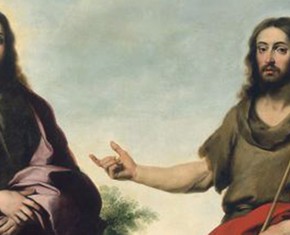The views expressed in our content reflect individual perspectives and do not represent the authoritative views of the Baha'i Faith.
Let’s be perfectly honest: There is no way to conclusively prove a prophetic claim.
But a prophetic claim may prove to be of great historical significance, over time, if the messianic claimant has attracted a sizable following of believers, thereby establishing a new religion that exerts its own religious and therefore historical influence.
Think of Jesus of Nazareth. There was simply no way to absolutely prove that Jesus was the “Anointed One”—the Messiah, or the Christ. But that messianic claim gave rise to what is now the world’s largest religion.
Religions begin small. If successful, they grow in size over time. At the crucial stage of a religion’s beginning, the founder’s messianic claims can make all the difference. So there is an historical dimension to a significant prophetic claim, which, after, all is an event in history, in and of itself.
The Baha’i Faith also began as a very small faith-community. Baha’u’llah’s messianic claim as the “Promised One” of all religions was a key ideological element that attracted the earliest followers, from several religions. These early believers, who accepted Baha’u’llah’s messianic claims, formed the early nucleus of what emerged as the Baha’i Faith.
When the first Baha’is reached India, they found a new religious and social environment. Since Hinduism was then, as now, the largest religion in India, it became necessary to present Baha’u’llah with prophetic credentials that were meaningful to faithful Hindus.
The result of these early teaching efforts can be seen now: India is currently the country with the largest population of Baha’is—an estimated two million adherents. Many readers have no doubt seen photographs of the magnificent Baha’i “Lotus Temple” in New Delhi. This marvelous piece of architecture, together with its universal spirit of openness and oneness, is said to attract more visitors each year than the Taj Mahal!
Baha’u’llah, according to Shoghi Effendi, is the “Tenth Avatar” and the return of Krishna:
To Him [Baha’u’llah] the Bhagavad-Gita of the Hindus had referred as the ’Most Great Spirit,’ the ’Tenth Avatar,’ the ’Immaculate Manifestation of Krishna’.” – God Passes By, p. 95.
Although the Bhagavad-Gita does not specifically refer to the “Tenth Avatar,” yet the great epic of India—the Mahabharata, of which the Bhagavad Gita is a part—does. No problem here. Shoghi Effendi was simply relying on the best information available to him at the time.
We have previously met the Tenth Avatar, Kalki Viṣṇuyaśas, “the fame of Viṣṇu” (Mahabharata 3.188.89a), who is seen as the Tenth Avatar, and who is a rebirth of Kṛṣṇa (Krishna), who takes birth from age to age (yuga to yuga) whenever religion (dharma) declines, according to Bhagavad Gita 4.7–8.
The Mahabharata claims to be a “history” (itihāsa). Although this may stretch our credulity when it comes to prophecy, no matter. Think of a prophecy as a kind of social mandate—a messianic “job description,” if you will—which will obviously attract more than one messianic claimant. Which claim is true cannot be proven historically or empirically, since we do not have access to the author’s original intent.
It’s not even clear how certain a prophecy is, since it can be understood as the projection of a “wish image” onto the event-horizon of future history. At the time of its writing, the great Indian epic was not aware of the later, modern convention of establishing a precise dividing-point between past and future. After all, the future is destined to become history in its own time.
Now let’s talk about the Hindu notion of time. A four-age yuga theory is found in Brahmanical texts. Some of these time-periods are greatly exaggerated. The result is that “time flies” over vast eons, rendering the Kalki prophecies themselves distant rather than close at hand, and therefore incapable of imminent fulfillment. This may be by design, in order to postpone the religious future, thereby maintaining the power, control and greater influence exercised by the Brahmin priests.
So, that said, does Baha’u’llah fit this messianic job description?:
For whenever there is a decline in righteousness (dharma) and an increase in un- righteousness, Arjuna, then I emanate myself. For the protection of good people, for the destruction of evil-doers, and for the restoration of righteousness, I take birth in age after age. – Bhagavad Gita 4.7–8, translated by Richard H. Davis, p. 24.
Here, “dharma,” according to Davis (professor of religion at Bard College), is the “harmonious order of things; code of proper conduct; righteousness” (p. 227). Krishna is an avatāra, which Professor Davis defines as an “incarnation; the ‘crossing down’ of divinity into earthly forms” (p. 226).
Krishna’s statement, which can be read as both past and future, is quite general, yet no less significant. Time will tell whether Baha’u’llah has (or will) fulfill Krishna’s prophecy, which is a social mandate for renewal and change, and a worldwide effort to bring about an era of peace and prosperity. It’s too soon to say, either way.
From a Baha’i perspective, the world is now in a transition zone between erosion of the old order and emergence of the new. Given the fact that Baha’u’llah’s greatest single national following in the world today is in India, this strengthens the distinct possibility that Baha’u’llah fulfills Krishna’s prophecy.
To Baha’is, this prophecy is a perfect fit when applied to Baha’u’llah. This is a matter of faith, which cannot be proven empirically.
Baha’is have a vision of the future, and are working to bring about a social transformation of consciousness, as practically applied to “community-building,” to establish a foundation for a better world, thereby paving the way to the future. For those investigating the Baha’i Faith and its spiritual truth-claims, such a determination is purely individual, pursuant to each person’s right and responsibility to “search after truth,” which is also a fundamental Baha’i principle.
And why not? As Professor Davis, in his Epilogue, concludes regarding the future of the Bhagavad Gita, and how this sacred text is being “spoken in multiple new ways to new audiences”:
This exploration of the Bhagavad Gita’s biography is part of that life, too. In reviewing some of the ways that the Gita has lived over the centuries, we have seen how the work has spoken in multiple new ways to new audiences. As Bakhtin writes, “There is neither a first word nor a last work …. Even meanings born in dialogues of the remotest past will never be grasped once and for all, for they will always be renewed in later dialogue.” We may be certain that this text will continue to reincarnate itself in new ways. – Richard H. Davis, The Bhagavad Gita: A Biography, p. 210.
The Baha’i International Community, in its 2005 official statement, “One Common Faith,” quotes Bhagavad Gita 4.7–8 (Sir Edwin Arnold’s translation), introduced by this statement: “The succession of revelations of the Divine also appears as an implicit—and usually explicit—feature of all the major faiths. One of its earliest and clearest expressions occurs in the Bhagavad-Gita” (p. 32).
You May Also Like
Comments

















“They call him Indra, Mitra, Varuṇa, Agni, and he is heavenly nobly-winged Garutmān. To what is One, sages give many a title they call it Agni, Yama, Mātariśvan.”
– Rig Veda, Book I, Hymn CLXIV, Verse 46, tr. by Ralph T.H. Griffith (1896).
Also: “Truth is progressive.”
Baha’is call this gradual unfolding of Truth, over the course of religious history: “Progressive Revelation.”
I doubt that the “seven rishis” knew about such Baha’i principles as the “equality of women and men” and the “harmony of science and religion,” because ...these truths were revealed much later.
So, if I may take this liberty with the text: “Truth is one — and progressive.”
Otherwise, I agree with you.